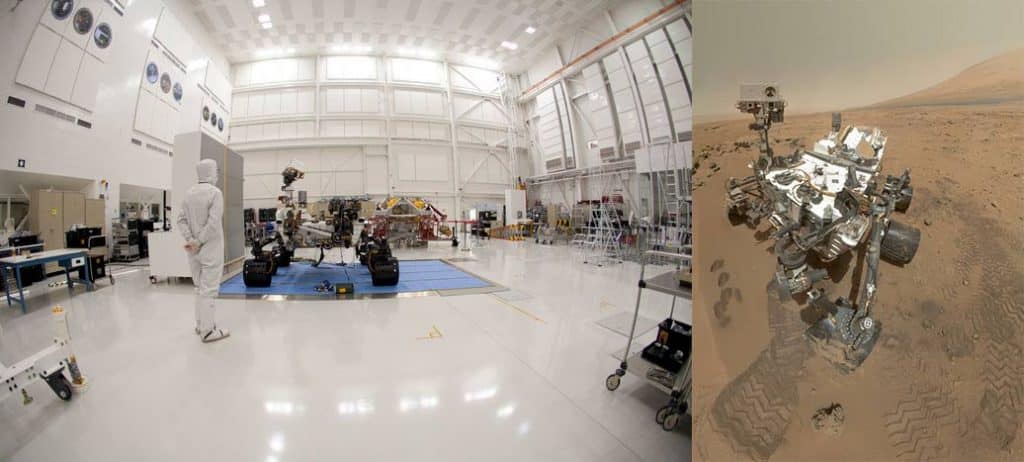A new study published in PLoS ONE describes how to detect spaceship- hitchhiking microbes in order to protect other planets in our solar system from contamination. The collaborative research identified particular genes and suites of genes that are associated with the potential to survive interplanetary space. Identifying these genes can help NASA clean their spacecraft before launch, ensuring that Earth microbes don’t “hitchhike” to other worlds where scientists are searching for life.
The genomics and computational biology teams at the Translational Genomics Research Institute (TGen), part of City of Hope, and Northern Arizona University (NAU) co-authored the paper in collaboration with a researcher at NASA’s Jet Propulsion Laboratory (JPL), which assembles interplanetary spacecraft. JPL has long had a Planetary Protection Program (PPP) aimed at preventing hitchhiking microbes from being transported from Earth to other planets where they might potentially proliferate and contaminate these other worlds. Mars, because of the many NASA missions, has been the primary concern, but planned missions to Europa and other Jupiter moons that contain liquid water are becoming more important.
“One of our great fears as we seek life on other planets is to find it, only to discover that it was seeded by ourselves in previous missions,” said JPL senior research scientist and study co-author Kasthuri Venkateswaran. “The NASA Planetary Protection Program was designed to construct and assemble spacecraft in a highly clean and low-biomass environment.”
Previously, the PPP evaluated spacecraft cleanliness by growing the microbes found on the spacecraft. This has been the traditional culture-based microbiology approach since Viking days. However, this is problematic since microbiologists can culture less than 1 percent of the known microorganisms. The JPL team sought out the expertise in the Flagstaff team to sample and sequence DNA directly from the samples collected from various stages of the facilities and without any culturing. Advances in sequence technology that directly sequence DNA from an environmental sample is called metagenomic and these are finding many environmental applications.
In addition to laboratory sequencing technologies, high-capacity computational approaches were required to handle enormous amounts of data.
“TGen and NAU have both invested heavily in supercomputers in order to handle the data explosion in genomics,” said Paul Keim, senior author, Regents’ professor at NAU and a TGen distinguished professor. “Without this information analysis power, all the laboratory data in the world is useless. We need to thank the State of Arizona for supporting cutting-edge technologies that are used daily by our faculty, staff and students.”
Computational analysis of metagenomic data leads to the identification of known microbes, but also to the discovery of new ones. NASA has special concerns about microbes that can resist the rigors of interplanetary space travel with its extreme temperatures, vacuum, and high radiation conditions. Earth abounds with examples of extremophiles and microbes that can survive in high radiation environments. This research was able to identify particular genes and suites of genes that are associated with the potential to survive interplanetary space. This allowed for the identification of concerning microbes even if they are being identified for the first time. NASA requirements specified that unbiased and comprehensive methods be developed and this team succeeded.
“With the innovative, sensitive, and intelligent technology demonstrated in this study, NASA and other interplanetary space programs, will be capable of monitoring its operations and reacting to prevent stowaway microbes,” said David Engelthaler, co-author and director of TGen’s Pathogen and Microbiome Division. “We see the impact of exotic species invasions on Earth, and we don’t want to be a party to this on other planets.”
Viacheslav Fofanov, director and associate professor of the School of Informatics, Computing, and Cyber Systems at NAU, also is a co-author on the paper.
The first author of this study, Sarah Highlander, who died during the writing of this paper, was a pioneering woman in the field of genomics and in particular the field of microbial genomics. This paper represents the last of a stellar career in science.
“Sarah Highlander was a talented and productive microbiology and molecular genetics researcher in multiple areas of importance in medicine, infectious diseases and agriculture,” said George Weinstock from The Jackson Laboratory for Genomic Medicine. “Her contributions were on both the academic and commercial sides as well as in education. She will be missed, but her work will continue to have impact.”
Top photo: The Curiosity rover’s bare bones are shown inside a cleanroom during the flight system Assembly, Test and Launch Operations in 2011. Prior to launch, the Mars Science Laboratory mission personnel processed approximately 4,500 samplings and 48,000 individual culture plates for Planetary Protection reviews. Credit: NASA.



